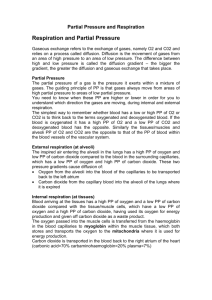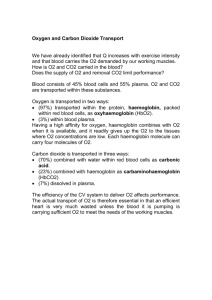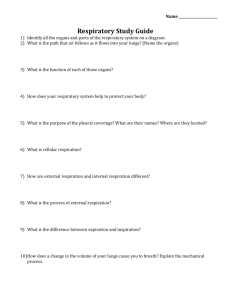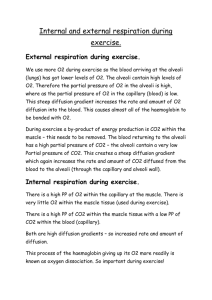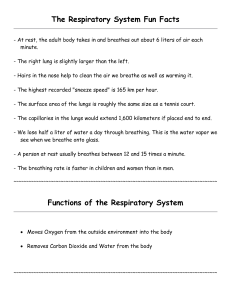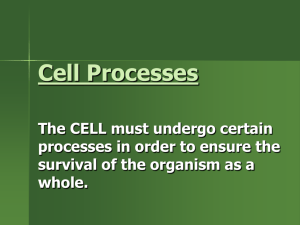Gas exchange. - Keswick School PE Department.
advertisement
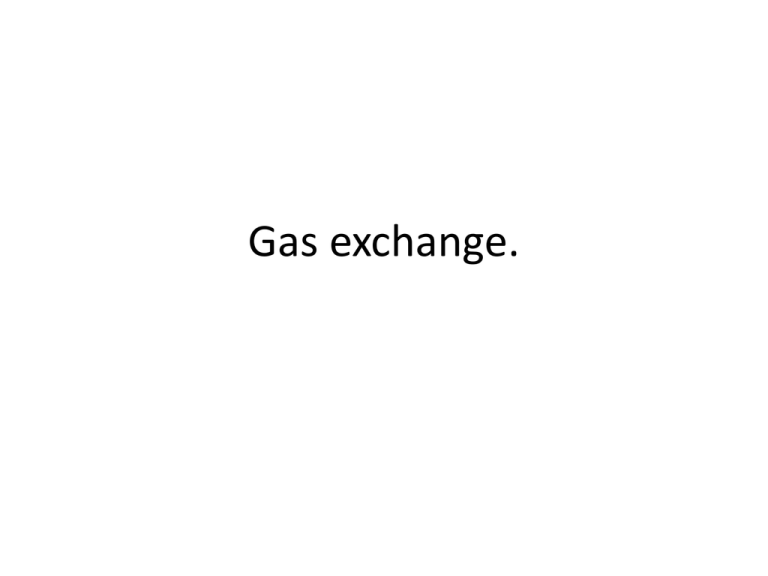
Gas exchange. Key terms: • Gas exchange refers to the exchange of gases, namely oxygen and carbon dioxide and relies on a process called diffusion. • Diffusion is the movement of gases from an area of high pressure to an area of low pressure. The difference between the high and low pressure is called the diffusion gradient- the bigger the gradient, the greater the diffusion and gas exchange that takes place. • Partial Pressure of a gas is the pressure it exerts within a mixture of gases. Gas always moves from areas of high pressure to areas of low pressure. External Respiration Inspired air entering the alveoli in the lungs has a high partial pressure of oxygen and a low partial pressure of carbon dioxide. Air in the deoxygenated blood of the capillaries has a low partial pressure of oxygen and a high partial pressure of carbon dioxide. External Respiration Therefore gas exchange occurs and… -diffusion of oxygen from the alveoli into the blood of the capillaries occurs to be transported to the left atrium of the heart. -diffusion of carbon dioxide from the capillary blood into the alveoli of the lungs where it is expired. Internal Respiration. The oxygenated blood is then pumped around the body until it reaches the capillaries surrounding the muscles. The capillary blood has a high partial pressure of oxygen and a low partial pressure of carbon dioxide. The muscle cells/tissues have a low partial pressure of oxygen because it has been used for energy production, and a high pressure of carbon dioxide which has been produced as a by product. Internal Respiration Therefore, gas exchange occurs and… -the oxygen passed into the muscle cells is transferred from haemoglobin in the blood capillaries to myoglobin, which stores and transports oxygen to the mitochondria where it is used for energy production. -carbon dioxide is transported in the blood as carbonic acid, carbaminohaemoglobin and plasma back to the right atrium of the heart. Make your own flow chart/diagram/table that represents gas exchange. Key terms to include: Gas exchange Diffusion Partial Pressure External Respiration Internal Respiration The oxyhaemoglobin dissociation curve • 97% of oxygen is carried in the blood by haemoglobin • Fully saturated haemoglobin carries 4 oxygen molecules. • Haemoglobin is fully saturated when the partial pressure of oxygen is high, e.g. the alveolar capillaries at the lungs. The oxyhaemoglobin dissociation curve • At the lungs, the partial pressure of oxygen is high therefore haemoglobin is fully saturated. At the tissues, partial pressure of oxygen is low, therefore haemoglobin gives up some of its oxygen. • During exercise, deoxygenated blood has an even higher partial pressure of carbon dioxide and the oxygenated blood at the lungs has an even higher partial pressure of oxygen, therefore increasing the diffusion gradient. This results in greater and quicker gas exchange therefore greater saturation. The oxyhaemoglobin dissociation curve • • • • Under certain conditions (exercise) haemoglobin gives up some of its oxygen more readily and the S-shaped curve shifts to the right. This is important during exercise when there is a greater demand for oxygen. These conditions are: Increase in temperature of the blood/muscle. Decrease in partial pressure of oxygen in the muscle, increasing the oxygen diffusion gradient. Increase in partial pressure of carbon dioxide during exercise, increasing the carbon dioxide diffusion gradient. An increase in acidity caused by an increase in carbon dioxide levels in the blood during exercise, lowering the PH (Bohr effect). The oxyhaemoglobin dissociation curve All of these factors increase during exercise. The effect is that the working muscles: - Generate more heat when working - Use more oxygen to provide energy, lowering the PP of oxygen - Produce more carbon dioxide as a by-product - Increase lactic acid levels, which increases blood/muscle acidity, therefore lowering PH. The oxyhaemoglobin dissociation curve Collectively, all 4 of these factors increase the dissociation of oxygen from haemoglobin, which increases the supply of oxygen to the working muscles and therefore delays fatigue and increases the possible intensity/duration of performance. Exam Questions. • Describe the process of oxygen diffusion at the alveoli during exercise. (3 marks) • During exercise there is an increased supply of oxygen to the working muscles. Describe the processes of internal respiration which allow more oxygen to be diffused into the muscle cell during exercise. (5 marks)
